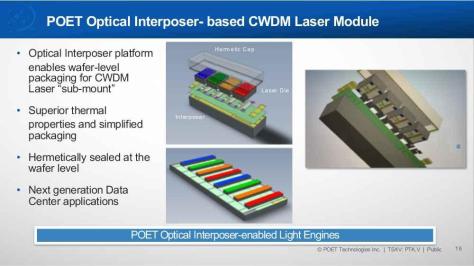Using the optical interposer for laser integration into Silicon Photonics
in response to
by
posted on
Jan 24, 2019 12:49PM


The AGM presentation bit that I posted below takes on new meaning.
Recognising that laser integration is a long standing issue that has stalled the development of silicon photonics I think we can now see how POETs optical interposer provides a critical answer.
Based on the statements made by Suresh in December (linked) I think that there are customers that will want to improve their existing investments in silicon photonics by adding laser integration efficiently through a POET optical interposer solution. An early step before moving towards the full range of improvements offered by the POET optical interposer platform as it becomes available.
………………………………………………………………………………………………………………………………Slide 16

00:44:10 – This is an example of how the interposer would be used in the context of a laser assembly. This is actually a product that we’re working on now for another customer on the transmit side. So this is a CWDM, which stands for „coarse wavelength division multiplexing“. It’s four lasers, four wavelengths that are 20 nm apart, and a specific application could require either 4 or 12 or up to 16 of these lasers being placed onto the interposer. Why is this important? Because if you do it without an interposer, you have to place these individually and then align each one of them individually with the lenses that are required to insure the right amount of coupling. With our interposers, we promote a very high coupling efficiency between the lightsource and the waveguide. Our target is to be over 90 percent coupling efficiency versus – the norm in the industry is about 60 to 70 percent.
00:45:15 – That is one piece of it. The second piece is, we have advanced thermal management capability built into the interposer. The lasers are placed on the interposer, we have the ability to sink the heat out of these lasers in an efficient way. So that improves the performance of the lasers.
00:45:15 – And the third and probably most important is we passively place these lasers onto the interposer. So there’s no active alignment. When we sell a module with four to twelve lasers on it and provide it to the customer, they don’t need to – now actively – align twelve lasers or four lasers, it’s all pre-aligned for them, and it makes it easy for them to apply it in to their applications. So completely separate from the receive optical engines that we’ve been talking about over the past couple of quarters, this is another product application that we’re working with for another customer, also in the data center applications, utilizing the concepts of the interposer.
00:46:22 – The opportunities for us to make a dramatic difference in the way photonics chips are used and packaged is there, and our discussions with every customer that we have had over the past couple of quarters has borne out the fact that the strategy we put in place a year ago, and that we’ve been executing on, is in fact the right one. The market opportunities are very large: eight billion dollar plus growth opportunity over the next two to three years. A couple of these products with a couple of customers could drive a revenue opportunity for us north of seventy-five million dollars.